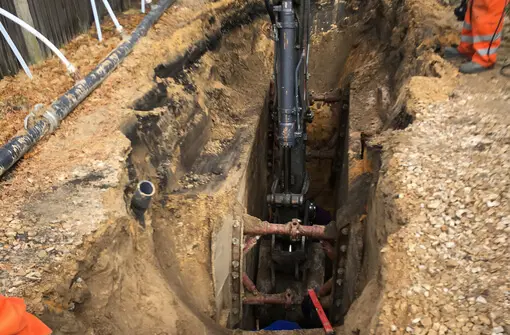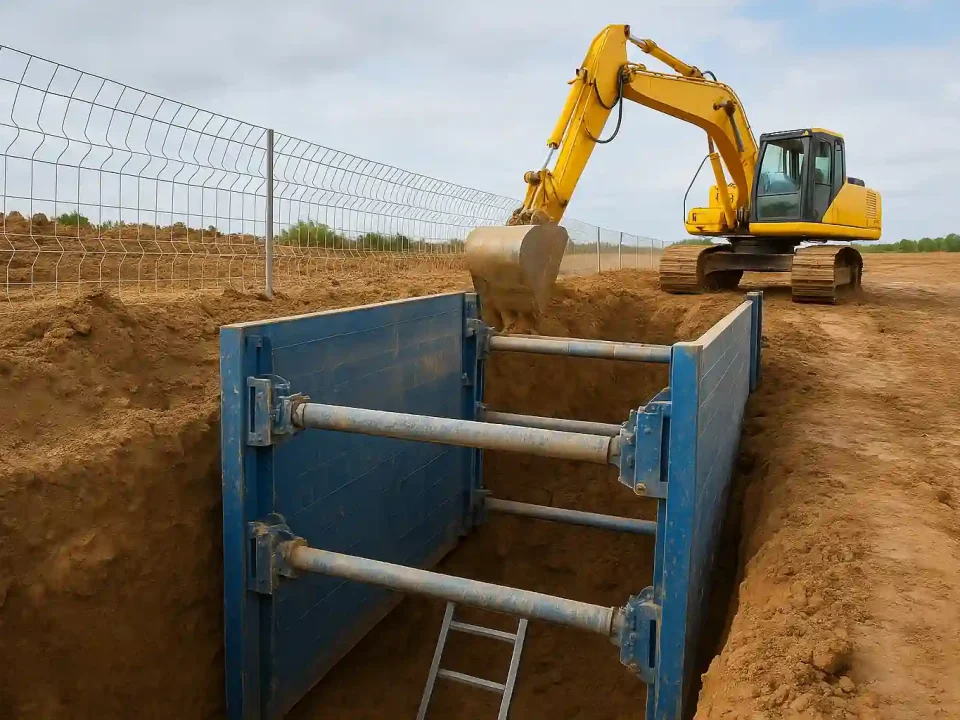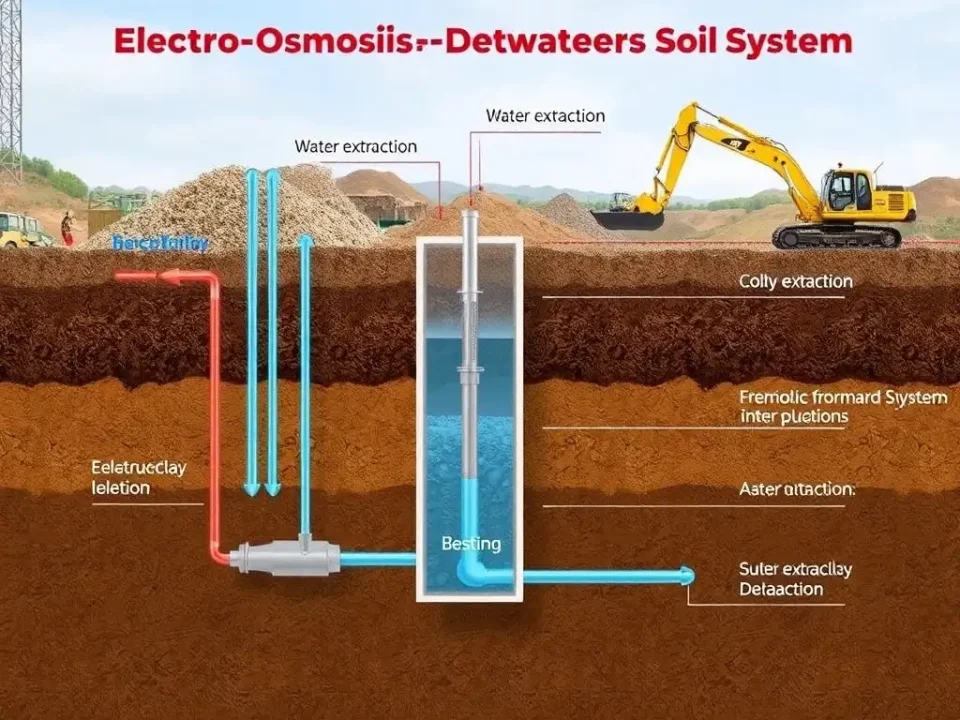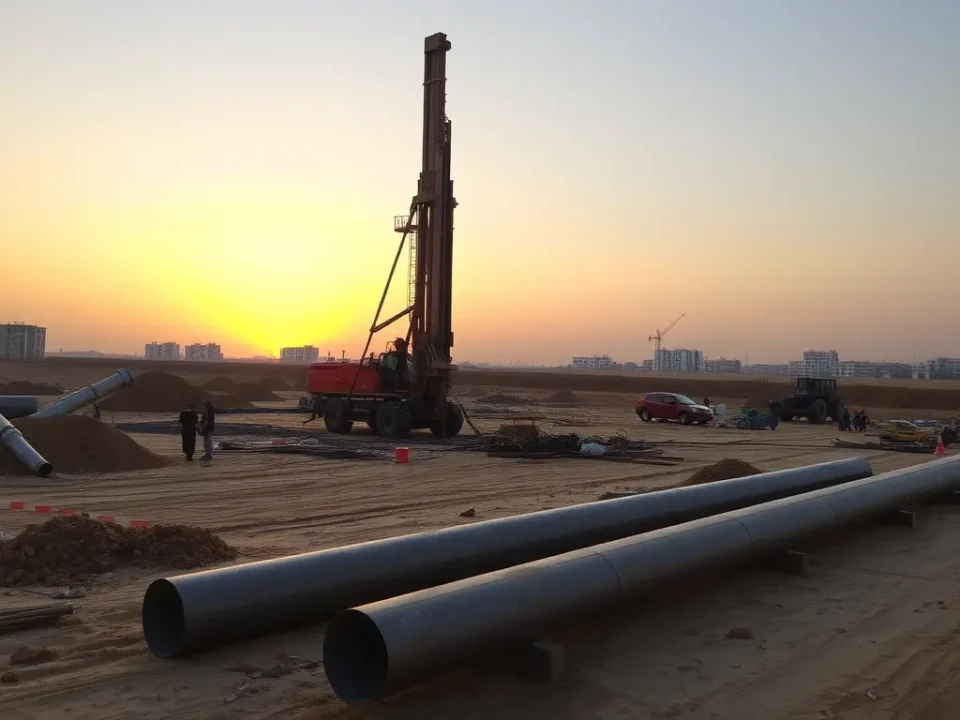
the Deep Well Point System:The Ultimate Dewatering Solution
December 26, 2024
7 Key Benefits of Mini Piles Construction
March 18, 20259 Factors for Choosing a Temporary Shoring for Excavation
Temporary shoring for excavation is a crucial safety measure used in construction projects to support the sides of an excavation site. This technique prevents soil collapse and protects workers and equipment from potential hazards. By utilizing various materials and methods, temporary shoring ensures stability during the excavation process, allowing for deeper and safer work environments. Effective temporary shoring for excavation not only enhances safety but also improves the efficiency of the construction project, making it a vital aspect of modern engineering practices.
What Is Temporary Shoring for Excavation?
Temporary shoring for excavation refers to the process of providing support to the walls of an excavation site to prevent soil movement and collapse. This method is essential for ensuring the safety of workers and the integrity of the excavation.
Types of Temporary Shoring for Excavation Systems
Temporary shoring for excavation can be categorized into several systems, each designed to meet specific site conditions and project requirements. Here are the most common types:
-
Soldier Piles and Lagging:
- Description: Vertical steel piles are driven into the ground, and wooden or steel lagging is placed horizontally between them.
- Usage: Commonly used for deep excavations where lateral support is needed.
-
Sheet Piling:
- Description: Interlocking sheets of steel, vinyl, or composite materials are driven into the ground to create a continuous wall.
- Usage: Effective in preventing soil movement and controlling groundwater.
-
Braced Excavations:
- Description: Cross braces are installed between the walls of the excavation to provide lateral support.
- Usage: Suitable for deep excavations and areas with unstable soil conditions.
-
Hydraulic Shoring:
- Description: Utilizes hydraulic systems to provide adjustable support to excavation walls.
- Usage: Allows for quick adjustments and is often used in areas with changing soil conditions.
-
Trench Boxes (Shielding):
- Description: Prefabricated, box-like structures placed in the trench to protect workers from cave-ins.
- Usage: Commonly used in shallow excavations, particularly for utility work.
-
Soil Nail Walls:
- Description: Long steel rods (nails) are inserted into the soil and grouted in place, providing reinforcement.
- Usage: Effective for stabilizing slopes and excavations in cohesive soils.
-
Cantilevered Shoring:
- Description: A system that uses vertical elements anchored at the top, with no braces extending into the excavation.
- Usage: Suitable for shallow excavations with limited space.
Each type of temporary shoring system is selected based on factors such as soil conditions, depth of the excavation, and project-specific requirements. Proper design and installation are essential for ensuring safety and effectiveness.
The Role of Temporary Shoring for Excavation in Projects
Temporary shoring for excavation plays a vital role in construction projects by providing essential support and safety measures during the excavation process. Here are some key aspects of its role:
-
Safety Assurance:
- Prevention of Soil Collapse: Temporary shoring prevents the walls of excavations from caving in, reducing the risk of accidents and injuries to workers.
- Protection of Equipment: By stabilizing the excavation site, shoring protects machinery and materials from potential damage due to soil movement.
-
Structural Integrity:
- Maintaining Stability: Shoring maintains the integrity of adjacent structures and utilities, preventing damage and ensuring that the excavation does not affect surrounding areas.
- Facilitating Deeper Excavations: It allows for deeper excavations that would otherwise be unsafe, enabling more complex construction projects.
-
Operational Efficiency:
- Streamlined Work Processes: With proper shoring in place, construction teams can work more efficiently, minimizing delays associated with soil instability.
- Reduced Downtime: Temporary shoring helps avoid costly delays that can arise from excavation-related accidents or soil issues.
-
Compliance with Regulations:
- Adhering to Safety Standards: Many regions have strict regulations regarding excavation safety. Temporary shoring helps ensure compliance with these laws, protecting both workers and the project.
-
Flexibility in Design:
- Adaptable Solutions: Temporary shoring systems can be designed and adjusted to accommodate various site conditions, making them versatile for different projects.
- Support for Innovative Techniques: Shoring allows for the use of advanced construction techniques, such as soil nailing or deep foundation systems.
-
Cost-Effectiveness:
- Preventing Damage Costs: By mitigating risks associated with soil movement, temporary shoring can save money by preventing damage to structures and reducing accident-related costs.
- Optimizing Resource Use: Efficient shoring can lead to better allocation of labor and equipment, enhancing overall project cost management.
In summary, temporary shoring for excavation is essential for ensuring safety, maintaining structural integrity, improving operational efficiency, and complying with regulations in construction projects. Its role is critical to the successful execution of excavation-related tasks, ultimately contributing to project success.
Proper Installation of Temporary Shoring Systems
The installation of temporary shoring systems is critical for ensuring safety and stability during excavation projects. Here are the key steps and considerations for proper installation:
-
Site Assessment:
- Soil Analysis: Conduct a thorough analysis of soil conditions to determine type, stability, and potential hazards.
- Site Survey: Evaluate the site for existing structures, utilities, and any environmental factors that may affect shoring.
-
Design Planning:
- Engineering Design: Engage a qualified engineer to design the shoring system based on site conditions, excavation depth, and load requirements.
- Selection of Materials: Choose appropriate materials (e.g., steel, timber, or aluminum) based on the design and expected loads.
-
Permits and Compliance:
- Obtain Necessary Permits: Ensure all required permits are secured before beginning installation.
- Adhere to Regulations: Follow local and national safety regulations and standards for shoring systems.
-
Installation Procedures:
- Marking the Area: Clearly mark the excavation site and shoring locations to facilitate organization and safety.
- Setting Up Equipment: Use appropriate equipment for installation, including cranes or excavators, as needed.
-
Installation of Shoring Components:
- Vertical Elements: Install vertical supports (e.g., soldier piles or sheet piles) securely into the ground based on design specifications.
- Horizontal Supports: Place lagging or braces between vertical elements to provide lateral support.
- Hydraulic Systems: If using hydraulic shoring, ensure all connections and components are properly secured and tested.
-
Inspection and Testing:
- Conduct Inspections: Regularly inspect shoring components during and after installation to ensure they are secure and functioning correctly.
- Load Testing: If required, perform load tests to verify the system can handle anticipated loads.
-
Safety Measures:
- Worker Training: Ensure all personnel involved in the installation are trained in safety procedures and shoring techniques.
- Personal Protective Equipment (PPE): Require the use of appropriate PPE, such as helmets, gloves, and safety vests.
-
Monitoring and Maintenance:
- Continuous Monitoring: Regularly monitor the shoring system throughout the excavation process for signs of movement or instability.
- Maintenance: Address any issues promptly and conduct maintenance as needed to ensure ongoing safety and effectiveness.
By following these steps, construction teams can install temporary shoring systems effectively, ensuring safety and stability during excavation operations. Proper installation is essential not only for compliance with regulations but also for the overall success of the project.
Differences Between Permanent Shoring and Temporary Shoring
| Feature | Permanent Shoring | Temporary Shoring |
| Purpose | Provides long-term support for structures | Supports during excavation or construction phases |
| Duration | Installed for the life of the structure | Removed after the construction phase is completed |
| Materials Used | Typically more robust materials (concrete, steel) | Often lighter materials (timber, aluminum, steel) |
| Design | Designed to integrate with the building’s structure | Designed for quick installation and removal |
| Cost | Higher initial cost due to durability and complexity | Generally lower cost, but may require multiple setups |
| Load Capacity | Built to support significant loads over time | Designed to handle temporary loads during construction |
| Installation | More complex and time-consuming installation | Quicker and simpler installation process |
| Regulatory Compliance | Must meet long-term building codes and standards | Must comply with safety regulations for temporary structures |
| Examples | Foundation walls, retaining walls | Trench boxes, hydraulic shoring |
This table outlines the key differences between permanent and temporary shoring systems, highlighting their distinct purposes, materials, and characteristics.
How to Dismantle Shoring Without Causing Soil Collapse
Dismantling shoring systems requires careful planning and execution to prevent soil collapse and ensure the safety of workers. Here are the key steps to follow:
-
Pre-Dismantling Assessment:
- Site Inspection: Conduct a thorough inspection of the shoring system and the surrounding area to identify any signs of instability or movement.
- Review Plans: Consult the original engineering plans to understand the shoring system’s configuration and load distribution.
-
Develop a Dismantling Plan:
- Sequential Removal: Create a detailed plan outlining the sequence in which components will be removed. Typically, this involves removing the top components first and working downwards.
- Stabilization Measures: Identify and implement any additional stabilization measures needed before dismantling begins, such as adding temporary supports.
-
Communication and Safety Protocols:
- Worker Briefing: Gather all personnel involved in the dismantling process and review safety protocols, roles, and responsibilities.
- Use of PPE: Ensure all workers are equipped with appropriate personal protective equipment (PPE).
-
Dismantling Process:
- Remove Components Gradually: Start removing shoring components one at a time, beginning with non-load-bearing elements. Avoid sudden or rapid removal.
- Monitor Soil Conditions: Continuously monitor soil conditions for signs of movement or instability as components are removed.
-
Maintain Lateral Support:
- Support Adjacent Areas: As shoring components are removed, provide temporary support to adjacent areas if needed, using braces or other support systems.
- Avoid Overloading: Ensure that the remaining shoring system is not overloaded during the dismantling process.
-
Final Checks:
- Inspect Before Final Removal: Before removing the last components, thoroughly inspect the excavation for any signs of instability.
- Controlled Removal: Remove the final shoring components carefully and slowly, ensuring that soil stability is maintained.
-
Post-Dismantling Monitoring:
- Ongoing Observation: After dismantling, continue to monitor the excavation site for any signs of soil movement or collapse.
- Document the Process: Keep detailed records of the dismantling process for future reference and compliance with regulations.
By following these steps, construction teams can effectively dismantle shoring systems while minimizing the risk of soil collapse, ensuring the safety of workers and the integrity of the excavation site.
the Deep Well Point System:The Ultimate Dewatering Solution
Key Considerations for Choosing a Temporary Shoring System
Selecting the appropriate temporary shoring system is crucial for ensuring safety, efficiency, and compliance in excavation projects. Here are the key considerations to keep in mind:
-
Soil Conditions:
- Type of Soil: Assess the soil type (cohesive, granular, etc.) to determine its stability and behavior under load.
- Soil Properties: Consider factors such as density, moisture content, and shear strength, which can influence the choice of shoring system.
-
Excavation Depth and Width:
- Depth of Excavation: Deeper excavations typically require more robust shoring systems to handle increased lateral pressure.
- Width of Trench: Wider excavations may necessitate different shoring configurations to ensure stability.
-
Load Requirements:
- Static and Dynamic Loads: Evaluate the loads that will be placed on the shoring system, including equipment, materials, and potential vibrations from nearby activities.
- Safety Factors: Incorporate safety factors into the design to account for unexpected loads or conditions.
-
Site Conditions:
- Adjacent Structures: Consider the proximity of nearby buildings, utilities, and other structures that may be affected by the excavation.
- Access and Space Limitations: Assess the available space for installation and removal of the shoring system, as well as access for equipment and workers.
-
Regulatory Compliance:
- Local Regulations: Ensure the chosen shoring system complies with local building codes and safety regulations.
- Engineering Standards: Follow recognized engineering standards for design and installation.
-
Type of Shoring System:
- System Options: Evaluate different types of shoring systems (e.g., soldier piles, sheet piling, hydraulic shoring) based on project needs.
- Flexibility and Adaptability: Consider whether the system can be easily adjusted or modified as project requirements change.
-
Cost and Budget:
- Material Costs: Analyze the cost of materials and installation, balancing safety and efficiency with budget constraints.
- Long-Term Considerations: Factor in potential future costs related to maintenance, removal, and any required modifications.
-
Installation and Dismantling:
- Ease of Installation: Choose a system that can be installed efficiently and safely, considering the availability of equipment and labor.
- Dismantling Process: Assess how easily the system can be dismantled, ensuring that safety is maintained during removal.
-
Experience and Expertise:
- Consultation with Professionals: Engage experienced engineers and contractors to provide insights and recommendations based on past projects.
- Training and Safety: Ensure that personnel involved in the installation and management of the shoring system are properly trained in safety practices.
By considering these factors, project managers and engineers can make informed decisions when selecting a temporary shoring system, ultimately enhancing safety and project success.
Elevate Your Construction Projects with aramenco
At Aramenco , we pride ourselves on being Kuwait’s leading shoring and piling company. Our expert team utilizes state-of-the-art technology and proven techniques to provide top-notch support solutions tailored to your project needs. With a commitment to safety, efficiency, and quality, we ensure your construction projects stand strong and resilient. Trust aramenco for unparalleled service and results!
FAQ: Temporary Shoring for Excavation
How do I choose the right shoring system?
Consider factors such as soil conditions, excavation depth, project duration, space constraints, and budget. Consulting a geotechnical engineer can also help.
What are OSHA requirements for temporary shoring?
OSHA mandates that any excavation deeper than 5 feet must have protective systems, including shoring, shielding, or sloping, unless the excavation is in stable rock.
Can temporary shoring be reused?
Yes, some shoring systems, like hydraulic shores and trench boxes, are designed for reuse, while others, such as timber shoring, may degrade over time and require replacement.
How much does temporary shoring cost?
Costs vary depending on the method, materials, excavation size, and rental vs. purchase options. It is best to get quotes from multiple shoring companies for accurate pricing.
How long can temporary shoring stay in place?
Shoring systems are designed for short-term use, but the duration depends on the project timeline, soil stability, and weather conditions.
What are the risks of not using temporary shoring?
Without proper shoring, excavation sites risk soil collapse, worker injuries, structural damage to nearby buildings, and legal penalties for non-compliance.
Is temporary shoring needed for small excavations?
It depends on the depth and soil conditions. Even shallow excavations may require support if the soil is unstable.
Can temporary shoring be used in wet conditions?
Yes, but additional waterproofing and drainage solutions may be required to prevent water buildup from weakening the shoring system.




